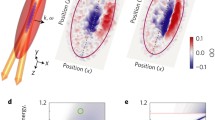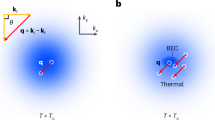Abstract
A Bose–Einstein condensate (BEC) with periodically modulated interactions (PMI) has emerged as a novel kind of periodic superfluid, which has been recently experimentally created using optical Feshbach resonance. In this paper, we are motivated to investigate the superfluidity of a BEC with PMI trapped in an optical lattice (OL). In particular, we explore the effects of PMI on the sound speed and the dynamical structure factor of the model system. Our numerical results, combined with the analytical results in both the weak-potential limit and the tight-binding limit, have shown that the PMI can strongly modify the sound speed of a BEC. Moreover, we have shown that the effects of PMI on the sound speed can be experimentally probed via the dynamic structure factor, where the excitation strength toward the first Bogoliubov band exhibits a marked difference from the non-PMI one. Our predictions of the effects of PMI on the sound speed can be tested using the Bragg spectroscopy.





Similar content being viewed by others
References
C. Chin, R. Grimm, P. Julienne, E. Tiesinga, Rev. Mod. Phys. 82, 1225 (2010)
M. Theis, G. Thalhammer, K. Winkler, M. Hellwig, G. Ruff, R. Grimm, J.H. Denschlag, Phys. Rev. Lett. 93, 123001 (2004)
R. Qi, H. Zhai, Phys. Rev. Lett. 106, 163201 (2011)
R. Yamazaki, S. Taie, S. Sugawa, Y. Takahashi, Phys. Rev. Lett. 105, 050405 (2010)
I. Bloch, J. Dalibard, W. Zwerger, Rev. Mod. Phys. 80, 885 (2008)
G. Raithel et al., Phys. Rev. Lett. 78, 630 (1997)
T. Müller-Seydlitz et al., Phys. Rev. Lett. 78, 1038 (1997)
S.E. Hamann et al., Phys. Rev. Lett. 80, 4149 (1998), and references therein
S. Friebel, C. D’Andrea, J. Walz, M. Weitz, T.W. Hänsch, Phys. Rev. A 57, R20 (1998)
M. Raizen, C. Salomon, Q. Niu, Phys. Today 50, 30 (1997)
L. Guidoni, P. Verkerk, Phys. Rev. A 57, R1501 (1998). and references therein
L. Guidoni, C. Triché, P. Verkerk, G. Grynberg, Phys. Rev. Lett. 79, 3363 (1997)
K.I. Petsas, A.B. Coates, G. Grynberg, Phys. Rev. A 50, 5173 (1994)
I.H. Deutsch, P.S. Jessen, Phys. Rev. A 57, 1972 (1998)
K. Berg-Sørensen, K. Mølmer, Phys. Rev. A 58, 1480 (1998)
D.I. Choi, Q. Niu, Phys. Rev. Lett. 82, 2022 (1999)
B. Wu, Q. Niu, Phys. Rev. A 64, 061603(R) (2001)
E.J. Mueller, Phys. Rev. A 66, 063603 (2002)
A. Polkovnikov, E. Altman, E. Demler, B. Halperin, and M.D. Lukin, Phys. Rev. A. 71, 063613 (2005)
V.I. Yukalov, Laser Phys. 19, 1 (2009)
O. Morsch, J.H. Müller, M. Cristiani, D. Ciampini, E. Arimondo, Phys. Rev. Lett. 87, 140402 (2001)
L. Fallani, L.D. Sarlo, J.E. Lye, M. Modugno, R. Saers, C. Fort, M. Inguscio, Phys. Rev. Lett. 93, 140406 (2004)
O. Morsch, M. Oberthaler, Rev. Mod. Phys. 78, 179 (2006)
S.L. Zhang, Z.W. Zhou, B. Wu, Phys. Rev. A 87, 013633 (2013)
J. Stenger, S. Inouye, A.P. Chikkatur, D.M. Stamper-Kurn, D.E. Pritchard, W. Ketterle, Phys. Rev. Lett. 82, 4569 (1999)
D.M. Stamper-Kurn, A.P. Chikkatur, A. Görlitz, S. Inouye, S. Gupta, D.E. Pritchard, W. Ketterle, Phys. Rev. Lett. 83, 2876 (1999)
J.M. Vogels, K. Xu, C. Raman, J.R. Abo-Shaeer, W. Ketterle, Phys. Rev. Lett. 88, 060402 (2002)
J. Steinhauer, R. Ozeri, N. Katz, N. Davidson, Phys. Rev. Lett. 88, 120407 (2002)
R. Ozeri, J. Steinhauer, N. Katz, N. Davidson, Phys. Rev. Lett. 88, 220401 (2002)
J. Steinhauer, N. Katz, R. Ozeri, N. Davidson, C. Tozzo, F. Dalfovo, Phys. Rev. Lett. 90, 060404 (2003)
X. Du, S. Wan, E. Yesilada, C. Ryu, D.J. Heinzen, Z. Liang, B. Wu, New. J. Phys. 12, 083025 (2010)
M. Krämer, C. Menotti, L. Pitaevskii, S. Stringari, Eur. Phys. J. D 27, 247 (2003)
C. Menotti, M. Krämer, L. Pitaevskii, S. Stringari, Phys. Rev. A 67, 053609 (2003)
Y. Hu, Z.X. Liang, Phys. Rev. Lett. 107, 110401 (2011)
Y. Hu, Z.X. Liang, Mod. Phys. Lett. B 27, 1330010 (2013)
Z.X. Liang, X. Dong, Z.D. Zhang, B. Wu, Phys. Rev. A 78, 023622 (2008)
D. Pines, P. Noziéres, The Theory of Quantum Liquids, vol. I (Benjamin, New York, 1966)
P. Noziéres, D. Pines, The Theory of Quatum Liquids, vol. II (Addison-Wesley, Reading, 1990)
E. Taylor, E. Zaremba, Phys. Rev. A 68, 053611 (2003)
D. Boers, C. Weiss, M. Holthaus, Europhys. Lett. 67, 887 (2004)
R. Ozeri, N. Katz, J. Steinhauer, N. Davidson, Rev. Mod. Phys. 77, 187 (2005)
Acknowledgments
We thank Ying Hu and Biao Wu for helpful and motivating discussions. This work is supported by the NSF of China (grant nos. 11004200 and 11274315).
Author information
Authors and Affiliations
Corresponding author
Sound Speed of a BEC with PMI in an OL: Perturbation Approach
Sound Speed of a BEC with PMI in an OL: Perturbation Approach
1.1 Weak-Potential Regime
In the weak potential and interaction regime where \(v\thicksim c_{2}\thicksim \lambda \) (\(\lambda \) is a small parameter), both the OL potential (\(v\)) and PMI (\(c_2\)) can be treated as a perturbation to a unperturbed system consisting of a homogeneous qusi-1D BEC. For the considered case in our work where PMI has the same period with OL, we could develop a perturbation theory through the expansion of the condensate wave function \(\psi \left( x\right) \) up to second order of the small parameters, i.e.
Following the standard procedure [36], we calculate the condensate wave function and the chemical potential order by order, and the results are
and
with
Furthermore, we proceed to derive the energy of the BEC, and then calculate the effective mass \(m^{*}\) and the compressibility \(\kappa \), respectively. The results are as follow,
and
It thus follows from Eqs. (22) and (23) that the sound speed is derived as
1.2 Tight-Binding Regime
We now turn to the tight-binding regime where \(v\gg c_{2}\) ( while the system is still kept in the superfluid regime). We can write the condensate wave function \(\psi \left( x\right) \) as
where \(L\) denotes the position of different unit cells and \(f\) denotes the Wannier function. Having in mind that \(f\left( x\right) \) is well localized, we only take into account the overlap between the Wannier functions associated with the nearest-neighbouring sites. By substituting Eq. (25) into Eq. (5), after some straightforward algebra, we arrived at the energy per particle reading
Here, \(\varepsilon _{0}\) is the on-site energy and \(\tau \) is the tunnelling parameter. More specifically, we have calculated \( \varepsilon _{0}=\frac{1}{2k_{L}}\int f\left( x\right) \left\{ -\frac{1}{2}\frac{\partial ^{2}}{\partial x^{2}}+v\cos \left( x\right) +\frac{1}{2}\left[ c_{1}+c_{2}\cos \left( x\right) \right] df\left( x\right) ^{2}\right\} f\left( x\right) dx\). Note that \(\varepsilon _{0}\) depends on the parameters \(v\), \(c_{1}\) and \(c_{2}\), but not on the wave vector \(k\). The tunnelling parameter \(\tau \) is given by
We must point out that during the derivation of Eq. (26), the term \(\int f^{2}\left( x\right) f^{2}\left( x\!-\!d\right) dx\) was omitted, which for localized functions, turn out to be much smaller, whereas the term \(\int f^{3}\left( x\right) f\left( x-d\right) dx\) was kept. Deep in the tight-binding regime, the Wannier function \(f\left( x\right) \) can be approximated by a Gaussian form \(f\left( x\right) =\exp \left[ -\left( x+\frac{d}{2}\right) ^{2}/\left( 2\sigma ^{2}\right) \right] /\left( \pi ^{1/4}\sqrt{\sigma }\right) \), where \(\sigma \) is the extension of the Gaussian which can be determined by minimizing the energy of the system. After straightforward calculations, the width \(\sigma \) and the inverse compressibility are derived as
The effective mass can be obtained from a standard procedure [36], and here we present the final result
With both the compressibility \(\kappa \) and the effective mass \(m^*\) being derived, we can readily calculate the sound speed in in the tight-binding regime. Our analytical result is consistent with the numerical calculations (Fig. 2) in corresponding regimes, suggesting that the tight-binding treatment in Eq. (25) is a reliable method.
Rights and permissions
About this article
Cite this article
Chen, L., Li, W., Chen, Z. et al. Probing Sound Speed of an Optically-Trapped Bose Gas with Periodically Modulated Interactions by Bragg Spectroscopy. J Low Temp Phys 177, 291–304 (2014). https://doi.org/10.1007/s10909-014-1210-9
Received:
Accepted:
Published:
Issue Date:
DOI: https://doi.org/10.1007/s10909-014-1210-9




